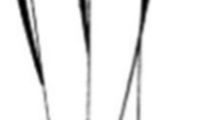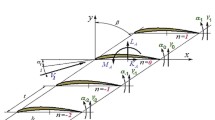Generalization of experimental investigation results for direct compressor cascades of blade profiles at a subsonic (continuous and separated) gas flow with bending, torsional, and bending-torsional vibrations created the basis for defining the physical mechanisms of subsonic flutter initiation in AGTE axial-flow compressor blade cascades. Such a combination of reduced frequencies and angles of attack is possible when the aerodynamic blade vibration decrement equals zero. It corresponds to the critical reduced vibration frequency value below which the aeroexcitation of blade vibrations and an increase in its level are observed, i.e., the dynamic subsonic cascade flutter loss is taking place. Known methods of evaluating these critical loss conditions are analyzed. The rapid method of predicting the dynamic subsonic flutter stability for compressor blade cascades is described. The scheme of critical reduced blade vibration frequency data base generation is tabulated as the critical values at fixed geometric cascade parameters (pitch-chord ratio and deflection angle), angles of attack, and coefficients of bending-torsional coupling. An example of such a data base for specific compressor blade cascades is given.





Similar content being viewed by others
References
E. K. Armstrong and R. E. Stevenson, “Some practical aspects of compressor blade vibration,” J. R. Aeronaut. Soc., 64, No. 591, 117–130 (1960).
A. V. Srinivasan, “Flutter and resonant vibrations characteristics of engine blades,” J. Eng. Gas Turb. Power, 119, 742–775 (1997).
E. A. Lokshtanov, V. M. Mikhailov, and A. A. Khorikov, Statistical Flutter Prediction for Turbomachine Blades. Aeroelasticity of Turbomachines [in Russian], Naukova Dumka, Kiev (1980), pp. 73–81.
Tszi and Srinivasan, “Some recent advances in studying the nature of stall flutter in turbomachines,” Énerg. Mash. Ustan., 107, No. 2, 113–124 (1985).
V. R. Capece and Y. M. El-Aini, “Stall flutter prediction techniques for fan and compressor blades,” J. Propul. Power, 12, 800–806 (1996).
J. D. Jeffers II and C. E. Meece, Jr, “F100 fan stall flutter problem review and solution,” AAIA J. Aircraft, 12, No. 1, 350–357 (1975).
S. N. Smith, Discrete Frequency Sound Generation in Axial Flow Turbomachines, Aeronautical Research Council Reports and Memoranda, No. 3709, Her Majesty’s Stationery Office, London (1973).
F. O. Carta, “Coupled blade-disk-shroud flutter instabilities in turbojet engine rotors,” J. Eng. Power, 89, No. 3, 419–426 (1967).
A. Bölcs and T. H. Fransson, Aeroelasticity in Turbomachines. Comparison of Theoretical and Experimental Cascade Results, Communications de Laboratoire de Thermique Appliquée et de Turbomachines No. 13, EPFL, Lausanne (1986).
J. G. Marshall and M. Imregun, “A review of aeroelasticity methods with emphasis on turbomachinery applications,” J. Fluid. Struct., 10, 237–267 (1996).
L. Sbardella, A. I. Sayma, and M. Imregun, “Semi-structured meshes for axial turbomachinery blades,” Int. J. Numer. Meth. Fl., 32, No. 5, 569–584 (2000).
M. Imregun and M. Vahdati, “Aeroelasticity analysis of a bird-damaged fan assembly using a large numerical model,” Aeronaut. J., 103, No. 1030, 569–578 (1999).
M. Vahdati, A. I. Sayma, M. Imregun, and G. Simpson, “Core-compressor rotating stall simulation with a multi-bladerow model,” in: K. C. Hall, R. E. Kielb, and J. P. Thomas (Eds.), Unsteady Aerodynamics, Aeroacoustics and Aeroelasticity of Turbomachines, Springer (2006), pp. 313–329.
F. Sisto, S. Thangam, and A. Abdel-Rahimi, “Computational prediction of stall flutter in cascaded airfoils,” AAIA J., 29, No. 7, 1161–1167 (1991).
V. I. Gnesin and Yu. A. Bykov, “Numerical studies on aeroelastic characteristics of the turbomachine blade cascade operating under abnormal conditions,” Probl. Mashinostr., 7, No. 1, 31–40 (2004).
V. I. Gnesin and L. V. Kolodyazhnaya, “Numerical simulation of the aeroelastic state of the vibrating turbomachine blade cascade in the three-dimensional transonic nonviscous gas flow,” Probl. Mashinostr., 1, No. 2, 65–76 (1998).
V. A. Tsymbalyuk, A. P. Zinkovskii, and A. V. Poberezhnikov, “Experimental-calculation determination of dynamic stability of blade assemblies of GTE compressor rotor wheels,” Strength Mater., 33, No. 6, 516–525 (2001).
A. Pajak and R. Rzadkowski, “Influence of mesh density and turbulence models on 2D viscous flutter in 11th standard configuration,” in: ASME Turbo Expo 2012: Turbine Technical Conference and Exposition (June 11–15, 2012, Copenhagen, Denmark), Vol. 7: Structures and Dynamics, Paper No. GT2012-68393, doi: https://doi.org/10.1115/GT2012-68393 (2012), pp. 1431–1439.
A. Rougerald-Sens and A. Dugeai, “Numerical unsteady aerodynamics for turbomachinery aeroelasticity,” in: K. C. Hall, R. E. Kielb, and J. P. Thomas (Eds.), Unsteady Aerodynamics, Aeroacoustics and Aeroelasticity of Turbomachines, Springer (2006), pp. 423–436.
A. L. Stel’makh, Ya. A. Stel’makh, and A. P. Zinkovskii, “Rapid assessment technique for dynamic subsonic cascade flutter stability of gas turbine engine compressor blades,” Aviats.-Kosm. Tekhn. Tekhnol., Issue 5 (40), 71–75 (2003).
A. A. Kaminer and A. L. Stel’makh, “Effect of the aerodynamic connectedness between blades on the aerodynamic damping of their vibrations, and origin of cascade flutter,” Strength Mater., 14, No. 12, 1667–1672 (1982).
A. L. Stel’makh and A. A. Kaminer, “Experimental study on cascade flutter-induced bending compressor blade vibrations,” in: Aeroelasticity of Turbomachines [in Russian], Proc. of Central Institute of Aviation Motors, No. 1064 (1983), pp. 273–284.
A. L. Stel’makh and A. A. Kaminer, “Effect of the geometrical parameters of a compressor cascade on the limit of bending self-oscillations of blades caused by cascade flatter,” Strength Mater., 15, No. 1, 104–109 (1983).
A. D. Len, A. A. Kaminer, A. L. Stel’makh, and V. A. Balalaev, “Loss of dynamic stability of torsional vibrations of blades due to cascade flutter,” Strength Mater., 18, No. 1, 76–80 (1986).
A. A. Kaminer, A. L. Stel’makh, and A. D. Len, “Experimental study on flutter-induced torsional autovibration limits for compressor blades,” in: Aeroelasticity of Turbomachines [in Russian], Proc. of Central Institute of Aviation Motors, No. 1127 (1985), pp. 96–104.
A. L. Stel’makh, “Aerodamping and stability of fan and compressor cascades under continuous and separated flow conditions,” Vibr. Tekhn. Tekhnol., No. 1 (10), 45–51 (1999).
A. L. Stel’makh, A. P. Zinkovskii, and Ya. A. Stel’makh, “Experimental-numerical investigation of the dynamic stability of flexural-torsional vibrations of compressor blades under conditions of attached and separated flow. Part 3. Mutual aerodynamic couplings,” Strength Mater., 42, No. 3, 304–312 (2010).
Author information
Authors and Affiliations
Corresponding author
Additional information
Translated from Problemy Prochnosti, No. 2, pp. 5 – 14, March – April, 2019.
Rights and permissions
About this article
Cite this article
Stel’makh, A.L., Zinkovskii, A.P. & Kabannik, S.N. Rapid Method of Predicting the Subsonic Flutter Stability of AGTE Axial-Flow Compressor Blade Cascades. Part 1. Physical Backgrounds of the Method. Strength Mater 51, 175–182 (2019). https://doi.org/10.1007/s11223-019-00063-y
Received:
Published:
Issue Date:
DOI: https://doi.org/10.1007/s11223-019-00063-y




